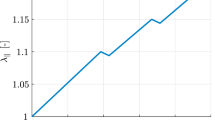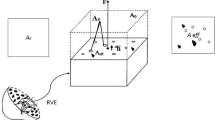Abstract
Recently, a new macro-mechanical model for ductile damage was presented by Wierzbicki, Xue et al., trying to address the role assumed by Lode angle and pressure sensitivity. The new model requires several experimental tests to identify all its parameters, but should outperform the “standard” formulations at high triaxiality levels. In this work a comparison between the Lemaitre’s Continuous Damage Mechanics model and the Wierzbicki’s one is proposed. After calibration of both models, the displacement field measured using the Digital Image Correlation technique in a large shear test case is compared with results of Finite Element simulations obtained using the two damage models considered. Results are not conclusive but show that the new damage model is quite accurateas rupture criterion, but damage evolution history deviates to some extent from the experimentally observed behavior.
















Similar content being viewed by others
Notes
Note that the authors of the damage model also propose a second formulation using directly the Lode angle that is not used in this work.
Low cycle fatigue data was extracted from material data sheet, i.e. 281 and 264 MPa respectively at 3,000 and 5,000 cycles.
Note that the same location is predicted even when \(\beta =2\).
References
Krajcinovic D (1998) Selection of damage parameter-art or science? Mech Mater 28(1–4):165–179
Krajcinovic D, Mastilovic S (1995) Some fundamental issues of damage mechanics. Mech Mater 21(3):217–230
Lemaitre J, Desmorat R, Sauzay M (2000) Anisotropic damage law of evolution. Eur J Mech–A/Solids 19(2):187–208
Gurson AL (1977) Continuum theory of ductile rupture by void nucleation and growth. J Eng Mater Technol 17(99):2–15
Nahshon K, Hutchinson JW (2008) Modification of the Gurson model for shear failure. Eur J Mech A/Solids 27(1):1–17
Tvergaard V (1989) Material failure by void growth to coalescence. Adv Appl Mech 27:83–151
Tvergaard V, Needleman A (1984) Analysis of the cup-cone fracture in a round tensile bar. Acta Metall 10(32):157–169
Lemaitre J (1985) A continuous damage mechanics model for ductile fracture. J Eng Mater Technol 107(2):83–89
Lemaitre J (1996) A course on damage mechanics, 2nd edn. Springer, Berlin
Lemaitre J, Dufailly J (1987) Damage measurements. Eng Fract Mech 28(5):643–661
Voyiadjis GZ (2001) Model of inelastic behavior coupled to damage, chap 9, section 9.4. Academic Press, New York, pp 814–820
Bai Y, Wierzbicki T (2008) A new model of metal plasticity and fracture with pressure and lode dependence. Int J Plast 24(6):1071–1096
Xue L (2007) Damage accumulation and fracture initiation in uncracked ductile solids subject to triaxial loading. Int J Solids Struct 44(16):5163–5181
Xue L (2009) Stress based fracture envelope for damage plastic solids. Eng Fract Mech 76(3):419–438
Xue L, Wierzbicki T (2008) Ductile fracture initiation and propagation modeling using damage plasticity theory. Eng Fract Mech 75(11):3276–3293
Voyiadjis GZ, Abed FH (2006) Implicit algorithm for finite deformation hypoelastic-viscoplasticity in fcc metals. Int J Numer Methods Eng 67(7):933–959
Xue L, Wierzbicki T (2009) Ductile fracture characterization of aluminum alloy 2024-t351 using damage plasticity theory. Int J Appl Mech 1(2):267–304
Xue L (2007) Ductile fracture modeling: theory, experimental investigation and numerical verification. PhD thesis, Massachusetts Institute of Technology
Bonora N, Newaz G (1998) Low cycle fatigue life estimation for ductile metals using a nonlinear continuum damage mechanics model. Int J Solids Struct 35(16):1881–1894
Bao Y, Wierzbicki T (2004) On fracture locus in the equivalent strain and stress triaxiality space. Int J Mech Sci 46(1):81–98
Wierzbicki T, Bao Y, Lee YW, Bai Y (2005) Calibration and evaluation of seven fracture models. Int J Mech Sci 47(4–5):719–743
Lode W (1925) Versuche über den einfluß der mittleren hauptspannung auf die fließgrenze. Z Angew Math Mech 5:142–144
Zhang KS, Bai JB, Francois D (2001) Numerical analysis of the influence of the Lode parameter on void growth. Int J Solids Struct 38(32–33):5847–5856
Bridgman PW (1952) Studies in large plastic flow and fracture. McGraw-Hill, New York
Coffin LF (1954) A study of the effect of cyclic thermal stresses on a ductile metal. Trans ASME 76:931–950
Manson SS (1965) Fatigue: a complex subject–some simple approximation. Exp Mech 5:193–226
Miner MA (1945) Cumulative damage in fatigue. J Appl Mech 12(3):159–164
Palmgren A (1924) Die lebensdauer von kugellagern. Z Ver Dtsch Ing 68(14):339–341
Lemaitre J, Dufailly J (1977) Modélisation et identification de l’endommagement plastique des métaux. In: 3-éme Congrés Française de Mécanique. Grenoble, France
Chaboche JL (1977) Sur l’utilisation des variables d’état interne pour la description de la viscoplasticité cyclique avec endommagement. In: Problèmes Non Linéaires de Mécanique, Symposium Franco-Polonais de Rhéologie et Mécanique, Cracow, pp 137–159
Lemaitre J (2001) Handbook of materials behavior models. Academic Press, New York
Lemaitre J, Desmorat R (2005) Engineering damage mechanics—suctile, creep, fatigue and brittle failures. Springer-Verlag, Berlin
Baldi A, Bertolino F, Ginesu F (2006) Analisi di un nuovo codice per la correlazione digitale di immagini basato sul principio degli elementi finiti. In: XXXV Convegno Nazionale AIAS—Ancona settembre 2006, pp 1–10
Roux S, Hild F (2008) Digital image mechanical identification (DIMI). ExpMech 48(4):495–508
Author information
Authors and Affiliations
Corresponding author
Rights and permissions
About this article
Cite this article
Baldi, A., Francesconi, L., Medda, A. et al. Comparing Two Damage Models Under Shear Stress. Exp Mech 53, 1105–1116 (2013). https://doi.org/10.1007/s11340-013-9715-8
Received:
Accepted:
Published:
Issue Date:
DOI: https://doi.org/10.1007/s11340-013-9715-8




